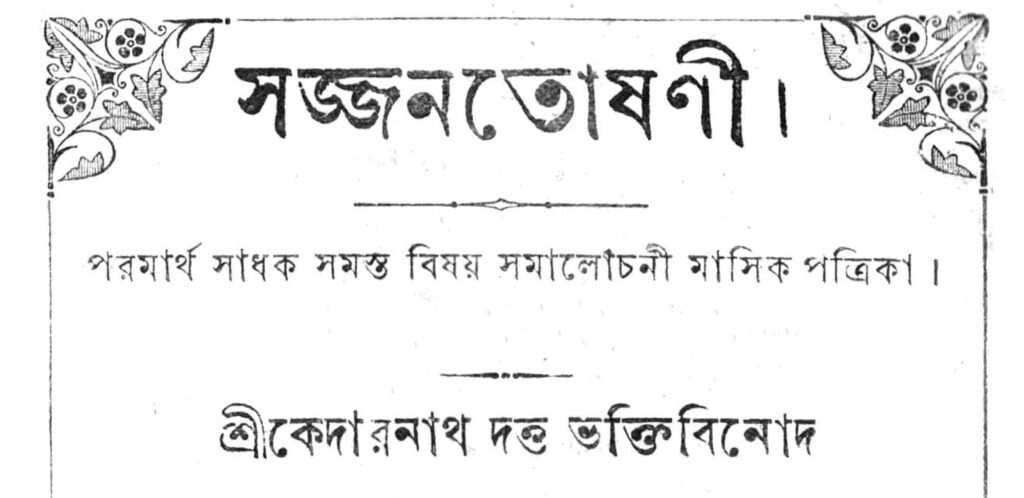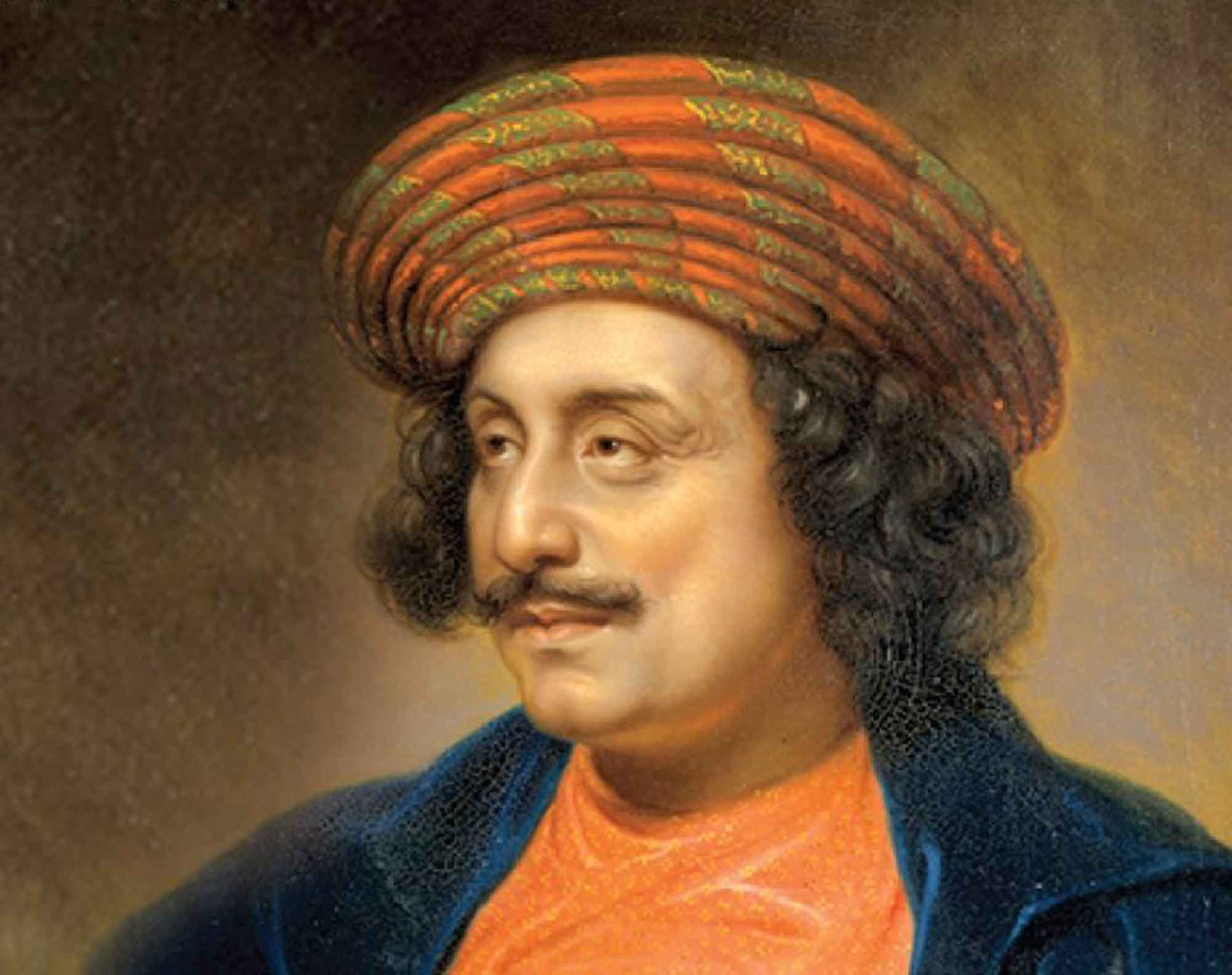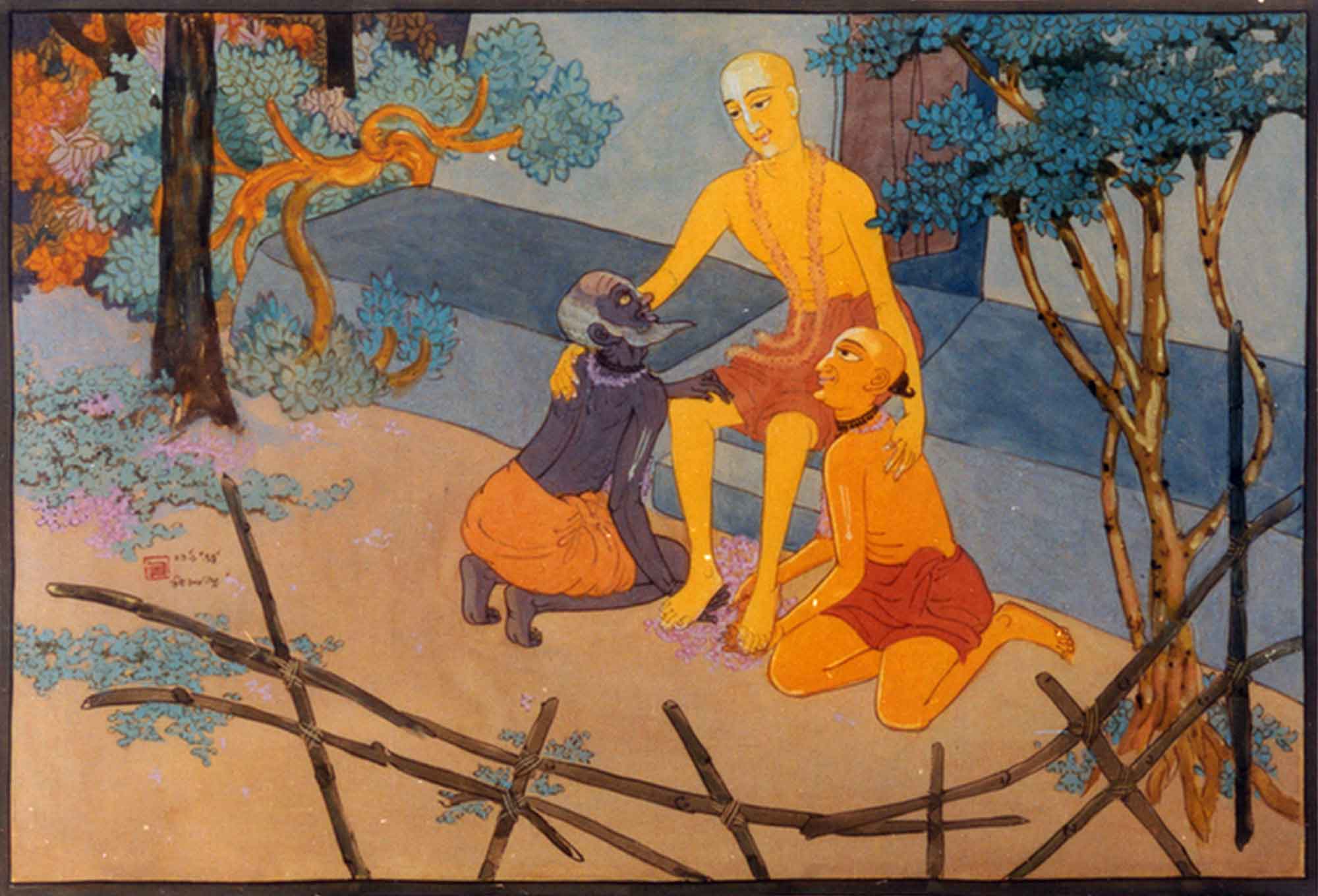Overview
In this early article, Śrī Nakula Brahmacārīra Pāṭa (The Place of Śrī Nakula Brahmacārī) first published in Śrī Viṣṇupriyā Patrikā, Vol.2, issue 3 in 1890, Śrīla Bhaktivinoda Ṭhākura talks about his visit on April 9th 1890 to the holy place of Nakula Brahmacārī, the eternal associate of Mahāprabhu. Bhaktivinoda speaks out against the present situation there and explains how the renunciant Vaiṣṇavas must be free from association with women.
(translated by Swami B.V. Giri)
Listen to this article:
There is a place called Pyārīgañj at the north-western end of Ambikā Nagara. The place of Brahmacārī Ṭhākura is still present there, and we went to visit it this morning. That place where his house is located is in a secluded area in the village of Pyārīgañj. First there is a flower garden. As soon as you cross the flower garden and enter the gate, you will notice a courtyard. A number of houses made from straw can be seen on three sides of the premises. On one side is a brick building for Śrī Śrī Mahāprabhu. I came to know that this place has seven bighās of land (about 2.5 acres) and there are ponds and various trees on it. All this land is used for the service of the Mahāprabhu. Money is also available from all the nearby villages. Śrī Mahāprabhu and Nityānanda reside in the temple. There is a very beautiful Gopāla and one śalagrāma. The place where the building is about half a krośa (over half a mile) from the Gaṅgā and half a poyā (about 8 kilometres) from the present paved road.
In the Śrī Caitanya-caritāmṛta, it is written:
bhakte kṛpā karena prabhu e-tina svarūpe
sākṣāt āveśa āra āvirbhāva-rūpe
sākṣāte sakala bhakta dekhe nirviśeṣa
nakula brahmacāri-dehe prabhura āveśa
pradyumna brahmacārī tāṅra āge nāma chila
nṛsiṁhānanda nāma prabhu pāche ta’ rākhila
tāṅhāte haila caitanyera āvirbhāva
alaukika aiche prabhura aneka svabhāva
(“The Lord bestows mercy on the devotees in three forms – directly [sākṣāt], through someone He empowers [āveśa], and His manifestation [āvirbhāva]. When the devotees directly experience Him, that is sākṣāt. The form of Nakula Brahmacārī is the Lord’s āveśa. He who was formerly called Pradyumna Brahmacārī was given the name Nṛsiṁhānanda Brahmacārī by the Lord. Within him was Śrī Caitanya’s āvirbhāva. Such things are uncommon, but the Lord displays various different features.” – Caitanya-caritāmṛta, Ādi-līlā 56-59)
Furthermore, Śrī Kavi Karṇapūra writes in Gaura-gaṇoddeśa Dīpikā:
āvirbhāvo gaura-harer nakula-brahmacāriṇi
āveśaś ca tathā jñeyo miśre pradyumna-saṁjñake
ācāryo bhagavān khañjaḥ kalā gaurasya kathyate
(“A manifestation of Gaurahari entered Nakula Brahmacārī. Thus he is understood as an āveśa just like he who is known as Pradyumna Miśra. The lame Bhagavān Ācārya is also said to be a partial manifestation of Gaura.” – Gaura-gaṇoddeśa Dīpikā 73-74)
Also in the Śrī Caitanya-bhāgavata:
āmbuyā-muluke nakula-brahmacārī
(“Nakula Brahmacārī resided in Āmbuyā-muluka”) *
*Translators Note: This verse is not found in Caitanya-bhāgavata, but a similar verse is found in Caitanya-caritāmṛta, Antya-līlā 2.16.
ei mate sapta-grāme āmbuyā-muluke
viharena nityānanda-svarūpa kautuke
(“In this way, Nityānanda Svarūpa blissfully performed pastimes in Sapta-grāma and Āmbuyā-muluka.”– Caitanya-bhāgavata, Antya-khaṇḍa 5.468)
In this way, the glories of Nakula Brahmacārī are described in many places in the Vaiṣṇava literature. Therefore, his home is one of the main viśrama-sthalas (‘a place away from mundane life’) of the Vaiṣṇava world. Nakula Brahmacārī was a renounced Vaiṣṇava, thus he had no offspring. Upon his disappearance, his residence was taken care of by one of his dear disciples. From disciple to disciple, the place came into the hands of Santośa Dāsa Bābājī. Santośa Dāsa Bābājī installed the two Deities of Śrī Śrī Mahāprabhu and Nityānanda. At the time of Brahmacārī Ṭhākura, only Gopāla was present. Within this area one can see the samādhi of Santośa Dāsa. After some time, Vraja Mohana Dāsa became the mahānta (main priest and caretaker) of this place. At the time when he left his body, Govinda Dāsa Bābājī became the mahānta and employed Śrīyuta Annadā Prasāda Majumdār Mahāśaya of Dhātrī-grama.
After some time, the mahānta, Govinda Dāsa, passed away in another region, and due to this irregularity, the post of mahānta basically became extinct. A most unfortunate thing has to be expressed about this place. The day we went to visit this place, the temple of Mahāprabhu was closed in the morning. After repeatedly calling, the door opened. I saw a Maharashtrian Vaiṣṇava. He has been serving the Lords for some days now. But he is unhappy to be there and will soon leave the place. If that happens then the service at the place of mahātmā Brahmacārī Ṭhākura will be infrequent. It is especially sad that the mahānta Govinda Dāsa had picked up a woman and kept her at that place, and another woman has come and stayed there for a long time. Now it seems that this place has fallen into the hands of women and they are its authority. The pūjārī is a bābājī who is kept there on a salary. Oh! What a horrible thing! Due to mahāntas like Govinda Dāsa Bābājī, all the temples of Gauḍa-bhūmi have become polluted. Fearing such faults, the Lord of our heart, Śrī Gaurāṅgadeva expelled Choṭa Hari Dāsa from Vaiṣṇava society. Upon seeing that, are such dharmadhvājīs (false renunciants) not afraid?
The conclusion of the śāstra is that there are two types of Vaiṣṇava – the householder and the renunciant. The householder Vaiṣṇava is situated with a wife and children in a Vaiṣṇava family and engages in worship according to pure Vaiṣṇava dharma. At a particular time, the Vaiṣnava renunciant gives up the association of women and stays at a place of bhajana, or constantly travels to the holy places and is engaged in cultivating service to Bhakti Devī. If a householder Vaiṣṇava attains virāga (detachment for material things), he is qualified to take the position of a renunciant. After accepting renunciation, he has no right to accept a woman. If he does so, he can no longer be accepted as a Vaiṣṇava. The injunction of the śāstra is that as long as there is attachment for the world within the heart, the eligibility to take sannyāsa without abandoning one’s wife and children will not appear. Those who take instant vairāgya and accept bhek (the cloth of a renunciant) at a very young age, are the ones who fall into debauched behaviour within a few days. All those persons that give bhek to such people also go to hell.
Thus, in the Saṁsāra Siddhānta:
aprāpte cādhikāre yaḥ kūryād ucchāśramāśrayaṁ
nāsti tasya śubhaṁ kvāpi gatir laghu harer iva
(“When one has not attained the proper qualification and he takes refuge in a higher āśrama, it brings no auspiciousness to him and it is insubstantial to attaining refuge in Hari.”)
And elsewhere there, it is said:
anyathaḥ kāla sannyāsa grahaṇena kṣipraṁ tad āśrama bhraṣṭatāḥ vaśyambhavī
sannyāsa dātur guror api patanam avaśyaṁ
(“At any time one accepts sannyāsa prematurely and falls from that āśrama due to attachment to women, the guru who gives sannyāsa certainly falls down.”)
We discovered that this maṭha had never been contaminated before Govinda Dāsa. From the time of Brahmacārī Ṭhākura to the time of Vraja-mohana Dāsa, this maṭha was under the shelter of pure Vaiṣṇavas. Brāhmaṇa paṇḍitas from nearby villages used to come to this maṭha and receive prasāda. That has almost stopped since the time of Govinda Dāsa. Although the maṭha has been polluted for some time by a person who has tarnished its name, it can be rescued with very little effort. Brāhmaṇa paṇḍitas and pure Vaiṣṇavas still have a special fondness for this place, and if this maṭha is handed over to a real Vaiṣṇava today, then the restoration of this maṭha’s reputation will start from tomorrow.
I see that Vraja-mohana Dāsa handed over the authority to appoint Govinda Dāsa as the mahānta to Śrīyukta Annadā Prasāda Majumdār Mahāśaya. Therefore, it all depends on the actions of Majumdār Mahāśaya. We hope that Majumdār Mahāśaya will appoint an advanced, senior pure Vaiṣnava as the mahānta of this maṭha without further ado.













